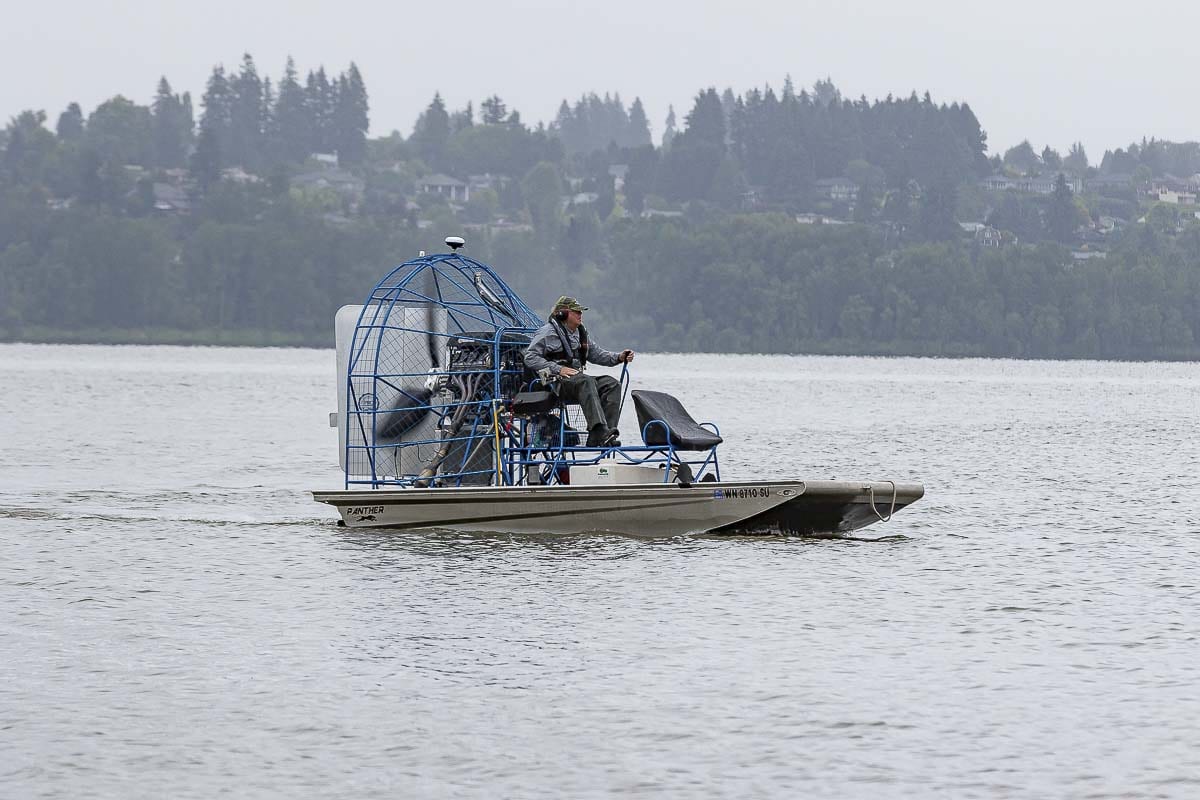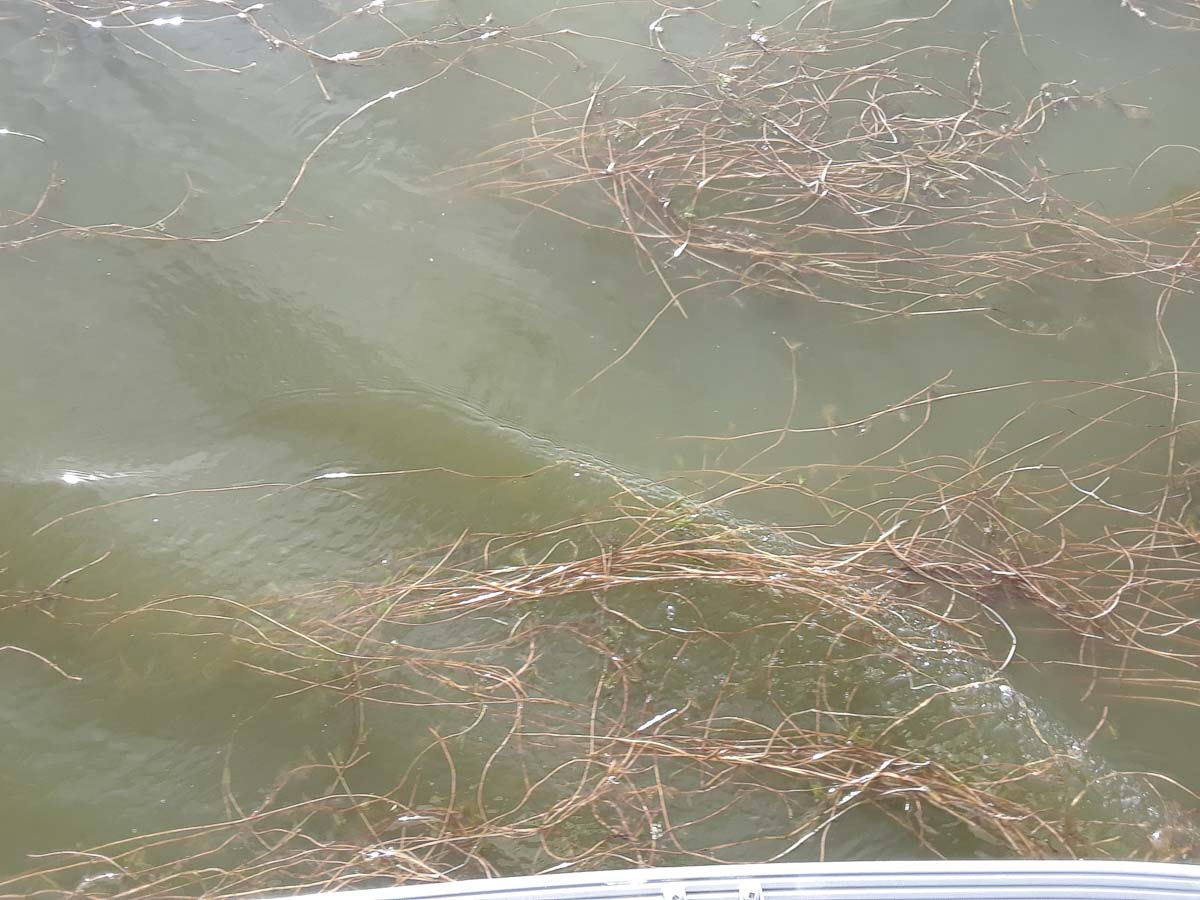Thursday’s survey showed significant injury to the EWM plants from application of the herbicide 10 days ago
VANCOUVER – Friends of Vancouver Lake (FoVL) today completed the first of two planned surveys to assess the impact of the July 7-8 treatment of Eurasian Watermilfoil (EWM) in Vancouver Lake.
EWM is a class B noxious weed in Washington state that requires mandatory control under state and local regulations. A second survey will be completed in mid-August.

EWM forms dense mats underneath the surface of the water and left untreated, quickly alters the ecosystem of water bodies threatening lake users, animals, and native species of plants and aquatic life. Without treatment, FoVL volunteers said EWM would cover the lake by 2021. Treatment included the Port-owned flushing channel. Cost of this year’s treatment was $157,000.
Thursday morning, applicator Terry McNabb of Bellingham-based AquaTechnex LLC, Alan Stewart of the Vancouver Lake Rowing Club, and Kathy Gillespie co-chair of FoVL, surveyed the treatment zones and adjacent areas for evidence of injury to EWM plants in order to assess the early impact of treatment. Thursday’s survey showed significant injury to the EWM plants from application of the herbicide 10 days ago. Full effect of the treatment will be seen after about three weeks.
“The results are progressing just as well as we expected them to,” said McNabb. “Importantly, our survey also showed native plants intact and healthy.”
The presence of EWM was first identified in spring 2018 by regular Lake users – primarily members of the Vancouver Lake Rowing Club and the Vancouver Lake Sailing Club who became alarmed as they noted widespread infestation and expansion into rowing, sailing, and swimming areas.

FoVL formed in late 2018 after finding no current or planned efforts to control EWM by local government agencies. The group joined with representatives of local rowing and sailing clubs to immediately begin working with local agencies, SW WA legislators, and the state Department of Ecology to apply for a permit to treat EWM as a private group. With the support of many allies, FoVL and the rowing club ultimately gained the Ecology permit to use newly-approved ProcellaCOR to treat the Lake’s EWM and contracted with AquaTechnex LLC to complete the treatment.
“FoVL is grateful for the support of 100s of community members who contributed funds to pay for this treatment and gratefully acknowledge the substantial financial support of the Firstenburg Foundation, the Ed and Dollie Lynch Foundation, J.L. Storedahl & Sons, Inc., Bo Storedahl, and Tapani Inc., Kevin Tapani,’’ read a FoVL statement Thursday. “In addition, FoVL received support from Clark County and the Port of Vancouver USA. These generous donors made the $157,000 treatment possible.
“FoVL is enormously grateful for the support of community members who understand the unique
beauty and importance of Vancouver Lake in SW WA for public recreation, competitive rowing, sailing, dragon boating and much more and have generously donated financially to EWM treatment,’’ the FoVL statement continued. “We are proud that treatment has been completed and that the Lake will continue to be accessible to all users. We also recognize that in the long term, water quality of the Lake must be improved and will continue to work on issues of water quality with local government, legislators, and state agencies to develop a lake management plan that will insure that this precious resource in our community will be preserved and protected.’’
Eurasian Watermilfoil and Vancouver Lake
EWM spreads through fragmentation and exists in many bodies of water throughout the state.
Fragmentation occurs by fish movements in shallow water, by swimmers or animals that become entangled in the weed, and by contact with boats, paddles, oars. Absent effective treatment and management, EWM returns annually and in greater numbers.
FoVL, the Department of Ecology, the Department of Fish and Wildlife and Clark County weed control will monitor effectiveness of the treatment and continue to survey the Lake for signs of new growth which must be addressed. Future management and treatment will occur through the county’s newly-minted Integrated Aquatic Vegetation Management Plan (IAVMP). FoVL participated extensively in development of the plan and will continue to support observation and treatment as part of its commitment to restoration of the Lake.
The herbicide ProcellaCOR, approved for use by the state Department of Ecology in 2019 and approved by the U.S. EPA as a reduced-risk herbicide with significantly reduced risk to the environment and human health, is selective and systemic with an extremely short contact exposure time requirement. Upon application, it moves into the plant rapidly and can be effectively applied in the very low parts per billion range. In addition, ProcellaCOR has minimal water use restrictions; it can be applied to potable water supplies with no restriction on the use of treated water for that purpose. It has no swimming or fishing restriction.
FoVL had previously planned to treat EWM in the summer of 2019 but rapidly deteriorating plant conditions halted the effort after biologists determined the dying plants would not absorb the systemic treatment. Current conditions show optimal plant size and reasonable water levels. EWM in the Port-owned flushing channel will be treated as well ensuring effectiveness of the Lake treatment. Port commissioners voted to financially support treatment and Port staff helped ensure access to the channel.




